Improving Urban Resilience Through a Scalable Multi-Criteria Planning Approach
Abstract
1. Introduction
2. Materials and Methods
2.1. Research Design Overview
- Definition of objectives and study area to identify and map territorial vulnerability patterns using open and harmonised spatial data in the municipality of Taranto (Southern Italy), an area exposed to multiple anthropogenic pressures;
- Selection of indicators and data processing based on the literature and policy relevance. We selected a set of indicators (land use, population density, proximity to emission sources, vegetation cover, presence of sensitive services, and AERMOD pollutant dispersion data) and harmonised them using a GIS-based environment. All layers were rasterised and normalised to ensure comparability;
- Multi-criteria analysis (MCA) based on a weighted overlay approach to integrate the indicators into a composite Territorial Vulnerability Index (TVI), using expert judgment and sensitivity analysis to define weights. The vulnerability values were classified into five levels, from low to high;
- Validation and spatial interpretation to validate the spatial coherence of the results through hotspot analysis, consistency checks with known pollution and population exposure data, and qualitative comparison with previous studies and environmental reports.
2.2. Study Area
2.3. Data Processing
2.3.1. Creation of Ground Fallout Maps and Identification of Isoconcentration Areas
2.3.2. Identification of Useful Themes and Calculation Grid
2.3.3. Multi-Criteria Analysis for the Calculation of the Territorial Vulnerability Index
- The concentration levels of PM10 air pollutants;
- The presence of sensitive infrastructure (e.g., schools, hospitals, and places of worship);
- The presence of urban and peri-urban green areas and the presence of natural areas to mitigate polluting loads;
- The presence of other sources of widespread pollution, such as intensive agriculture;
- The presence and extension of urban areas through land use.
2.3.4. Classification Model
- Very High Vulnerability: >0.70
- High Vulnerability: 0.70–0.60
- Moderate Vulnerability: 0.60–0.50
- Low Vulnerability: 0.50–0.40
- Very Low Vulnerability: <0.40
2.4. Nature-Based Solution Catalogue
2.5. The Data Elaboration Workflow
3. Results
- Low-vulnerability areas (agricultural or natural areas);
- Medium-vulnerability areas (transition or mixed zones);
- Vulnerability areas (urbanised and industrial zones) with low pollution levels;
- High-vulnerability areas (urbanised and industrial zones) with medium pollution levels;
- High-vulnerability areas (urbanised and industrial zones) with high pollution levels.
4. Discussion
- (1)
- Ground-truth comparison in which the vulnerability outputs were cross-checked and supported by historical environmental data and thematic maps of environmental criticalities in the area, including known pollution hotspots (e.g., proximity to industrial facilities, areas of limited vegetation cover, and contaminated and potentially contaminated sites);
- (2)
- Citizen-reported data consisting of additional confirmation of vulnerable areas obtained from citizen science data (e.g., location of sensitive receptors, perceived environmental risks, and green space accessibility), which were integrated into the analysis and contributed to model calibration.
5. Conclusions
Author Contributions
Funding
Data Availability Statement
Acknowledgments
Conflicts of Interest
References
- United Nations Human Settlements Programme (UN-Habitat). World Cities Report 2022: Envisaging the Future of Cities; UN-Habitat: Nairobi, Kenya, 2022. [Google Scholar]
- Li, X.; Yang, L.; Ren, Y.; Li, H.; Wang, Z. Impacts of Urban Sprawl on Soil Resources in the Changchun–Jilin Economic Zone, China, 2000–2015. Int. J. Environ. Res. Public Health 2018, 15, 1186. [Google Scholar] [CrossRef]
- Surya, B.; Salim, A.; Hernita, H.; Suriani, S.; Menne, F.; Rasyidi, E.S. Land Use Change, Urban Agglomeration, and Urban Sprawl: A Sustainable Development Perspective of Makassar City, Indonesia. Land 2021, 10, 556. [Google Scholar] [CrossRef]
- Massarelli, C. Developing a Calculation Workflow for Designing and Monitoring Urban Ecological Corridors: A Case Study. Urban Sci. 2024, 8, 169. [Google Scholar] [CrossRef]
- Liu, L.; Zhang, Y. Urban Heat Island Analysis Using the Landsat TM Data and ASTER Data: A Case Study in Hong Kong. Remote Sens. 2011, 3, 1535–1552. [Google Scholar] [CrossRef]
- de Almeida, C.R.; Teodoro, A.C.; Gonçalves, A. Study of the Urban Heat Island (UHI) Using Remote Sensing Data/Techniques: A Systematic Review. Environments 2021, 8, 105. [Google Scholar] [CrossRef]
- Zhou, D.; Xiao, J.; Bonafoni, S.; Berger, C.; Deilami, K.; Zhou, Y.; Frolking, S.; Yao, R.; Qiao, Z.; Sobrino, J.A. Satellite Remote Sensing of Surface Urban Heat Islands: Progress, Challenges, and Perspectives. Remote Sens. 2018, 11, 48. [Google Scholar] [CrossRef]
- Liu, F.; Hou, H.; Murayama, Y. Spatial Interconnections of Land Surface Temperatures with Land Cover/Use: A Case Study of Tokyo. Remote Sens. 2021, 13, 610. [Google Scholar] [CrossRef]
- Heaviside, C.; Macintyre, H.; Vardoulakis, S. The Urban Heat Island: Implications for Health in a Changing Environment. Curr. Environ. Health Rep. 2017, 4, 296–305. [Google Scholar] [CrossRef]
- Mirzaei, M.; Verrelst, J.; Arbabi, M.; Shaklabadi, Z.; Lotfizadeh, M. Urban Heat Island Monitoring and Impacts on Citizen’s General Health Status in Isfahan Metropolis: A Remote Sensing and Field Survey Approach. Remote Sens. 2020, 12, 1350. [Google Scholar] [CrossRef]
- Piracha, A.; Chaudhary, M.T. Urban Air Pollution, Urban Heat Island and Human Health: A Review of the Literature. Sustainability 2022, 14, 9234. [Google Scholar] [CrossRef]
- Shepherd, N. Making Sense of “Day Zero”: Slow Catastrophes, Anthropocene Futures, and the Story of Cape Town’s Water Crisis. Water 2019, 11, 1744. [Google Scholar] [CrossRef]
- Massarelli, C.; Uricchio, V.F. The Contribution of Open Source Software in Identifying Environmental Crimes Caused by Illicit Waste Management in Urban Areas. Urban Sci. 2024, 8, 21. [Google Scholar] [CrossRef]
- Olsson, P.; Galaz, V. Social-Ecological Innovation and Transformation. In Social Innovation; Palgrave Macmillan: London, UK, 2012; pp. 223–247. [Google Scholar] [CrossRef]
- Massarelli, C.; Campanale, C.; Uricchio, V.F. Characterization of Synanthropic Habitats on Shallow Seabeds Using Map Clustering Techniques: A Case Study in Taranto, Apulia, Italy. Ecologies 2024, 5, 627–646. [Google Scholar] [CrossRef]
- Brasil, J.; Macedo, M.; Lago, C.; Oliveira, T.; Júnior, M.; Oliveira, T.; Mendiondo, E. Nature-Based Solutions and Real-Time Control: Challenges and Opportunities. Water 2021, 13, 651. [Google Scholar] [CrossRef]
- Dushkova, D.; Haase, D. Not Simply Green: Nature-Based Solutions as a Concept and Practical Approach for Sustainability Studies and Planning Agendas in Cities. Land 2020, 9, 19. [Google Scholar] [CrossRef]
- Ferreira, V.; Barreira, A.P.; Loures, L.; Antunes, D.; Panagopoulos, T. Stakeholders’ Engagement on Nature-Based Solutions: A Systematic Literature Review. Sustainability 2020, 12, 640. [Google Scholar] [CrossRef]
- Kyere-Boateng, R.; Marek, M.V. Analysis of the Social-Ecological Causes of Deforestation and Forest Degradation in Ghana: Application of the DPSIR Framework. Forests 2021, 12, 409. [Google Scholar] [CrossRef]
- Wantzen, K.M.; Alves, C.B.M.; Badiane, S.D.; Bala, R.; Blettler, M.; Callisto, M.; Cao, Y.; Kolb, M.; Kondolf, G.M.; Leite, M.F.; et al. Urban Stream and Wetland Restoration in the Global South—A DPSIR Analysis. Sustainability 2019, 11, 4975. [Google Scholar] [CrossRef]
- Khan, M.M.H.; Kurniawan, T.A.; Chandra, I.; Lei, T.M.T. Modeling PM10 Emissions in Quarry and Mining Operations: Insights from AERMOD Applications in Malaysia. Atmosphere 2025, 16, 369. [Google Scholar] [CrossRef]
- US EPA. Air Quality Dispersion Modeling—Preferred and Recommended Models. Available online: https://www.epa.gov/scram/air-quality-dispersion-modeling-preferred-and-recommended-models (accessed on 19 May 2025).
- US EPA. AERMOD Modeling System Development. Available online: https://www.epa.gov/scram/aermod-modeling-system-development (accessed on 16 May 2025).
- US EPA. Interactive Map of Air Quality Monitors. Available online: https://www.epa.gov/outdoor-air-quality-data/interactive-map-air-quality-monitors (accessed on 4 August 2025).
- Kumar, A.; Dixit, S.; Varadarajan, C.; Vijayan, A.; Masuraha, A. Evaluation of the AERMOD Dispersion Model as a Function of Atmospheric Stability for an Urban Area. Environ. Prog. 2006, 25, 141–151. [Google Scholar] [CrossRef]
- Karagulian, F.; Belis, C.A.; Dora, C.F.C.; Prüss-Ustün, A.M.; Bonjour, S.; Adair-Rohani, H.; Amann, M. Contributions to Cities’ Ambient Particulate Matter (PM): A Systematic Review of Local Source Contributions at Global Level. Atmos. Environ. 2015, 120, 475–483. [Google Scholar] [CrossRef]
- Chen, J.; Hoek, G. Long-Term Exposure to PM and All-Cause and Cause-Specific Mortality: A Systematic Review and Meta-Analysis. Environ. Int. 2020, 143, 105974. [Google Scholar] [CrossRef]
- Goel, K.; Sen, A. Epidemiology of Fine Particulate Air Pollution and Human Health Impacts. In Air Quality and Human Health; Springer: Singapore, 2024; pp. 111–119. [Google Scholar] [CrossRef]
- Tunlathorntham, S.; Thepanondh, S. Prediction of Ambient Nitrogen Dioxide Concentrations in the Vicinity of Industrial Complex Area, Thailand. Air Soil Water Res. 2017, 10, 906. [Google Scholar] [CrossRef]
- Siahpour, G.; Jozi, S.A.; Orak, N.; Fathian, H.; Dashti, S. Estimation of Environmental Pollutants Using the AERMOD Model in Shazand Thermal Power Plant, Arak, Iran. Toxin Rev. 2022, 41, 1269–1279. [Google Scholar] [CrossRef]
- Mohd Shafie, S.H. Application of AERMOD Dispersion Model for Assessment PM10 Concentrations from Mobile Sources in Kuala Lumpur Metropolitan City, Malaysia. Environ. Monit. Assess. 2024, 196, 969. [Google Scholar] [CrossRef]
- Jittra, N.; Pinthong, N.; Thepanondh, S. Performance Evaluation of AERMOD and CALPUFF Air Dispersion Models in Industrial Complex Area. Air Soil Water Res. 2015, 8, 87–95. [Google Scholar] [CrossRef]
- Tartakovsky, D.; Broday, D.M.; Stern, E. Evaluation of AERMOD and CALPUFF for Predicting Ambient Concentrations of Total Suspended Particulate Matter (TSP) Emissions from a Quarry in Complex Terrain. Environ. Pollut. 2013, 179, 138–145. [Google Scholar] [CrossRef] [PubMed]
- Torrieri, F.; Batà, A. Spatial Multi-Criteria Decision Support System and Strategic Environmental Assessment: A Case Study. Buildings 2017, 7, 96. [Google Scholar] [CrossRef]
- Basílio, M.P.; Pereira, V.; Costa, H.G.; Santos, M.; Ghosh, A. A Systematic Review of the Applications of Multi-Criteria Decision Aid Methods (1977–2022). Electronics 2022, 11, 1720. [Google Scholar] [CrossRef]
- Verstand, D.; Berkhof, M.J.J.; de Haas, M.B.J.; Pellens, N.; Voskamp, I.M.; Diersmann, M.G.D. Nature-Based Solutions Catalogue: An Elaboration of 10 NbS Categories in the Dutch Situation 2024; WUR: Wageningen, The Netherlands, 2024. [Google Scholar]
- Aree Protette in Puglia—Paesaggio—SIT Puglia. Available online: https://pugliacon.regione.puglia.it/web/sit-puglia-paesaggio/aree-protette-in-puglia (accessed on 19 May 2025).
- National Centers for Environmental Information (NCEI). Available online: https://www.ncei.noaa.gov/ (accessed on 19 May 2025).
- Jacobson, M.Z. Fundamentals of Atmospheric Modeling, 2nd ed.; Cambridge University Press: Cambridge, UK, 2005; pp. 1–813. ISBN 9780521839709. [Google Scholar] [CrossRef]
- CORINE Land Cover—Copernicus Land Monitoring Service. Available online: https://land.copernicus.eu/en/products/corine-land-cover (accessed on 19 May 2025).
- Mooney, P. An Outlook for OpenStreetMap BT—OpenStreetMap in GIScience: Experiences, Research, and Applications; Springer: Berlin/Heidelberg, Germany, 2015; pp. 319–324. [Google Scholar]
- OpenStreetMap. Available online: https://www.openstreetmap.org/#map=14/40.46210/17.25600 (accessed on 19 May 2025).
- EVI. Sopac Unep Building Resilience in SIDS: The Environmental Vulnerability Index; South Pacific Applied Geoscience Commission and United Nations Environment Programme: Nairobi, Kenya, 2005. [Google Scholar]
- Di, M.C.; Nordvik, J.P.; Andrea, C.; Golia, E. Redazione Di Carte Tematiche Di Vulnerabilità e Rischio—Metodologia per l’Analisi Di Vulnerabilità Territoriale Su Scala Regionale. Rapporto Finale. 2007. Available online: https://publications.jrc.ec.europa.eu/repository/handle/JRC36070 (accessed on 4 August 2025).
- Saaty, T.L. Analytic Hierarchy Process. In Encyclopedia of Biostatistics; Wiley: New York, NY, USA, 2005. [Google Scholar] [CrossRef]
- Saaty, R.W. The Analytic Hierarchy Process—What It Is and How It Is Used. Math. Model. 1987, 9, 161–176. [Google Scholar] [CrossRef]
- Cutter, S.L.; Boruff, B.J.; Shirley, W.L. Social Vulnerability to Environmental Hazards. Soc. Sci. Q. 2003, 84, 242–261. [Google Scholar] [CrossRef]
- Malczewski, J. GIS and Multicriteria Decision Analysis; Wiley: New York, NY, USA, 1999; p. 392. [Google Scholar]
- Labianca, C.; De Gisi, S.; Todaro, F.; Notarnicola, M. DPSIR Model Applied to the Remediation of Contaminated Sites. A Case Study: Mar Piccolo of Taranto. Appl. Sci. 2020, 10, 5080. [Google Scholar] [CrossRef]
- Mangia, C.; Gianicolo, E.A.L.; Bruni, A.; Vigotti, M.A.; Cervino, M. Spatial Variability of Air Pollutants in the City of Taranto, Italy and Its Potential Impact on Exposure Assessment. Environ. Monit. Assess. 2013, 185, 1719–1735. [Google Scholar] [CrossRef]
- Gennaro, V.; Cervellera, S.; Cusatelli, C.; Miani, A.; Pesce, F.; De Gennaro, G.; Distante, A.; Vimercati, L.; Gesualdo, L.; Piscitelli, P. Use of Official Municipal Demographics for the Estimation of Mortality in Cities Suffering from Heavy Environmental Pollution: Results of the First Study on All the Neighborhoods of Taranto from 2011 to 2020. Environ. Res. 2022, 204, 112007. [Google Scholar] [CrossRef]
- Banini, T.; Palagiano, C. Environment and Health in Italian Cities: The Case of Taranto. In Environmental Deterioration and Human Health: Natural and Anthropogenic Determinants; Springer: Dordrecht, The Netherlands, 2014; pp. 17–37. [Google Scholar] [CrossRef]
- Bruno, P.; Caselli, M.; de Gennaro, G.; de Gennaro, L.; Tutino, M. High Spatial Resolution Monitoring of Benzene and Toluene in the Urban Area of Taranto (Italy). J. Atmos. Chem. 2006, 54, 177–187. [Google Scholar] [CrossRef]
- Cohen-Shacham, E.; Andrade, A.; Dalton, J.; Dudley, N.; Jones, M.; Kumar, C.; Maginnis, S.; Maynard, S.; Nelson, C.R.; Renaud, F.G.; et al. Core Principles for Successfully Implementing and Upscaling Nature-Based Solutions. Environ. Sci. Policy 2019, 98, 20–29. [Google Scholar] [CrossRef]
- Dorst, H.; van der Jagt, A.; Raven, R.; Runhaar, H. Urban Greening through Nature-Based Solutions—Key Characteristics of an Emerging Concept. Sustain. Cities Soc. 2019, 49, 101620. [Google Scholar] [CrossRef]
- Keesstra, S.; Nunes, J.; Novara, A.; Finger, D.; Avelar, D.; Kalantari, Z.; Cerdà, A. The Superior Effect of Nature Based Solutions in Land Management for Enhancing Ecosystem Services. Sci. Total Environ. 2018, 610–611, 997–1009. [Google Scholar] [CrossRef]
- Seddon, N.; Chausson, A.; Berry, P.; Girardin, C.A.J.; Smith, A.; Turner, B. Understanding the Value and Limits of Nature-Based Solutions to Climate Change and Other Global Challenges. Philos. Trans. R. Soc. B 2020, 375, 20190120. [Google Scholar] [CrossRef]
- García, L.; Mungaray-Moctezuma, A.; Montoya-Alcaraz, M.; Sánchez-Atondo, A.; Calderón-Ramírez, J.; Gutiérrez-Moreno, J.M. Analysis of Socio-Environmental Vulnerability in Areas with Overpopulation and Natural Risks Induced by Their Urban-Territorial Conditions. Appl. Sci. 2024, 14, 6535. [Google Scholar] [CrossRef]
- Massarelli, C.; Losacco, D.; Tumolo, M.; Campanale, C.; Uricchio, V.F. Protection of Water Resources from Agriculture Pollution: An Integrated Methodological Approach for the Nitrates Directive 91–676-Eec Implementation. Int. J. Environ. Res. Public Health 2021, 18, 13323. [Google Scholar] [CrossRef] [PubMed]
- Sabzevari, S.; Hofman, J. A Worldwide Review of Currently Used Pesticides’ Monitoring in Agricultural Soils. Sci. Total Environ. 2022, 812, 152344. [Google Scholar] [CrossRef] [PubMed]
- Feldman, E.E.; Eric, E. 1973-From Linear Spaces to Linear Places: Recycling Rail Corridors in Urban Areas; Massachusetts Institute of Technology: Cambridge, MA, USA, 2002. [Google Scholar]
- Benítez, G.; Alvarado-Castillo, G.; Guerrero, R.A.P.; Lara, M.A.C.; Williams, K.; Acosta, I. Designing a Green Belt for Xalapa City: Veracruz under Current Mexican Policies. Reg. Cohes. 2018, 8, 94–115. [Google Scholar] [CrossRef]
- Clevenot, L.; De Chastenet, C.; Frascaria, N.; Jacob, P.; Raymond, R.; Simon, L.; Pech, P. Do Linear Transport Infrastructures Provide a Potential Corridor for Urban Biodiversity? Case Study in Greater Paris, France. 2017. Available online: https://doi.org/10.4000/cybergeo.27895 (accessed on 4 August 2025).
- Hansen, A.L.M. 12 Remapping Philadelphia’s Postindustrial Terrain. In A Greene Country Towne; Penn State University Press: University Park, PA, USA, 2021; pp. 208–220. [Google Scholar] [CrossRef]
- Heathcott, J. The Promenade Plantée: Politics, Planning, and Urban Design in Postindustrial Paris. J. Plan. Educ. Res. 2013, 33, 280–291. [Google Scholar] [CrossRef]
- Zuniga-Teran, A.A.; González-Méndez, B.; Scarpitti, C.; Yang, B.; Murrieta Saldivar, J.; Pineda, I.; Peñúñuri, G.; Hinojosa Robles, E.; Irineo, K.S.; Müller, S.; et al. Green Belt Implementation in Arid Lands through Soil Reconditioning and Landscape Design: The Case of Hermosillo, Mexico. Land 2022, 11, 2130. [Google Scholar] [CrossRef]
- Mancilla, D.; Robledo, S.; Esenarro, D.; Raymundo, V.; Vega, V. Green Corridors and Social Connectivity with a Sustainable Approach in the City of Cuzco in Peru. Urban Sci. 2024, 8, 79. [Google Scholar] [CrossRef]
- Massarelli, C.; Galeone, C.; Savino, I.; Campanale, C.; Uricchio, V.F. Towards Sustainable Management of Mussel Farming through High-Resolution Images and Open Source Software—The Taranto Case Study. Remote Sens. 2021, 13, 2985. [Google Scholar] [CrossRef]
- Massarelli, C.; Campanale, C. Climatic, Bioclimatic, and Pedological Influences on the Vegetation Classification of “Bosco Dell’Incoronata” in Southern Italy. Rend. Lincei 2023, 34, 537–552. [Google Scholar] [CrossRef]
- Cavazzin, B.; MacDonell, C.; Green, N.; Rothwell, J.J. Air Pollution Biomonitoring in an Urban-Industrial Setting (Taranto, Italy) Using Mediterranean Plant Species. Atmos. Pollut. Res. 2024, 15, 102105. [Google Scholar] [CrossRef]
- Arriazu-Ramos, A.; Santamaría, J.M.; Monge-Barrio, A.; Bes-Rastrollo, M.; Gabriel, S.G.; Frias, N.B.; Sánchez-Ostiz, A. Health Impacts of Urban Environmental Parameters: A Review of Air Pollution, Heat, Noise, Green Spaces and Mobility. Sustainability 2025, 17, 4336. [Google Scholar] [CrossRef]
- Zarandi, S.M.; Shahsavani, A.; Nasiri, R.; Pradhan, B. A Hybrid Model of Environmental Impact Assessment of PM2.5 Concentration Using Multi-Criteria Decision-Making (MCDM) and Geographical Information System (GIS)—A Case Study. Arab. J. Geosci. 2021, 14, 177. [Google Scholar] [CrossRef]
- Hadi-Vencheh, A.; Tan, Y.; Wanke, P.; Loghmanian, S.M. Air Pollution Assessment in China: A Novel Group Multiple Criteria Decision Making Model under Uncertain Information. Sustainability 2021, 13, 1686. [Google Scholar] [CrossRef]
- Paatero, P. Least Squares Formulation of Robust Non-Negative Factor Analysis. Chemom. Intell. Lab. Syst. 1997, 37, 23–35. [Google Scholar] [CrossRef]
- Friend, A.J.; Ayoko, G.A.; Guo, H. Multi-Criteria Ranking and Receptor Modelling of Airborne Fine Particles at Three Sites in the Pearl River Delta Region of China. Sci. Total Environ. 2011, 409, 719–737. [Google Scholar] [CrossRef]
- Gupta, A.; De, B.; Shukla, A.K.; Pignatta, G. Vulnerability Assessment of a Highly Populated Megacity to Ambient Thermal Stress. Sustainability 2024, 16, 3395. [Google Scholar] [CrossRef]
- Vujovic, S.; Haddad, B.; Karaky, H.; Sebaibi, N.; Boutouil, M. Urban Heat Island: Causes, Consequences, and Mitigation Measures with Emphasis on Reflective and Permeable Pavements. CivilEng 2021, 2, 459–484. [Google Scholar] [CrossRef]
- Marando, F.; Salvatori, E.; Fusaro, L.; Manes, F.; Escobedo, F.; Livesley, S.J.; Morgenroth, J. Removal of PM10 by Forests as a Nature-Based Solution for Air Quality Improvement in the Metropolitan City of Rome. Forests 2016, 7, 150. [Google Scholar] [CrossRef]
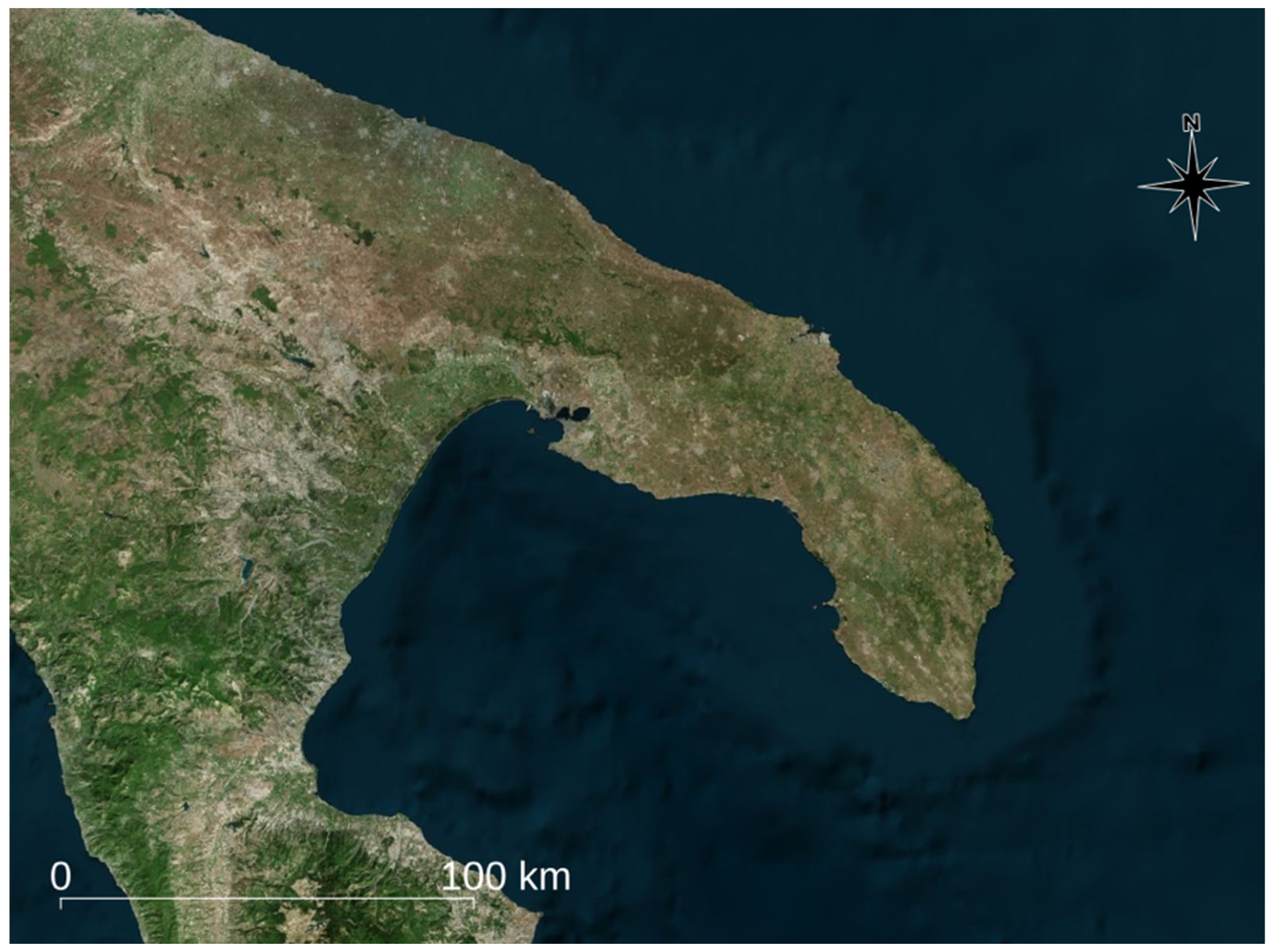
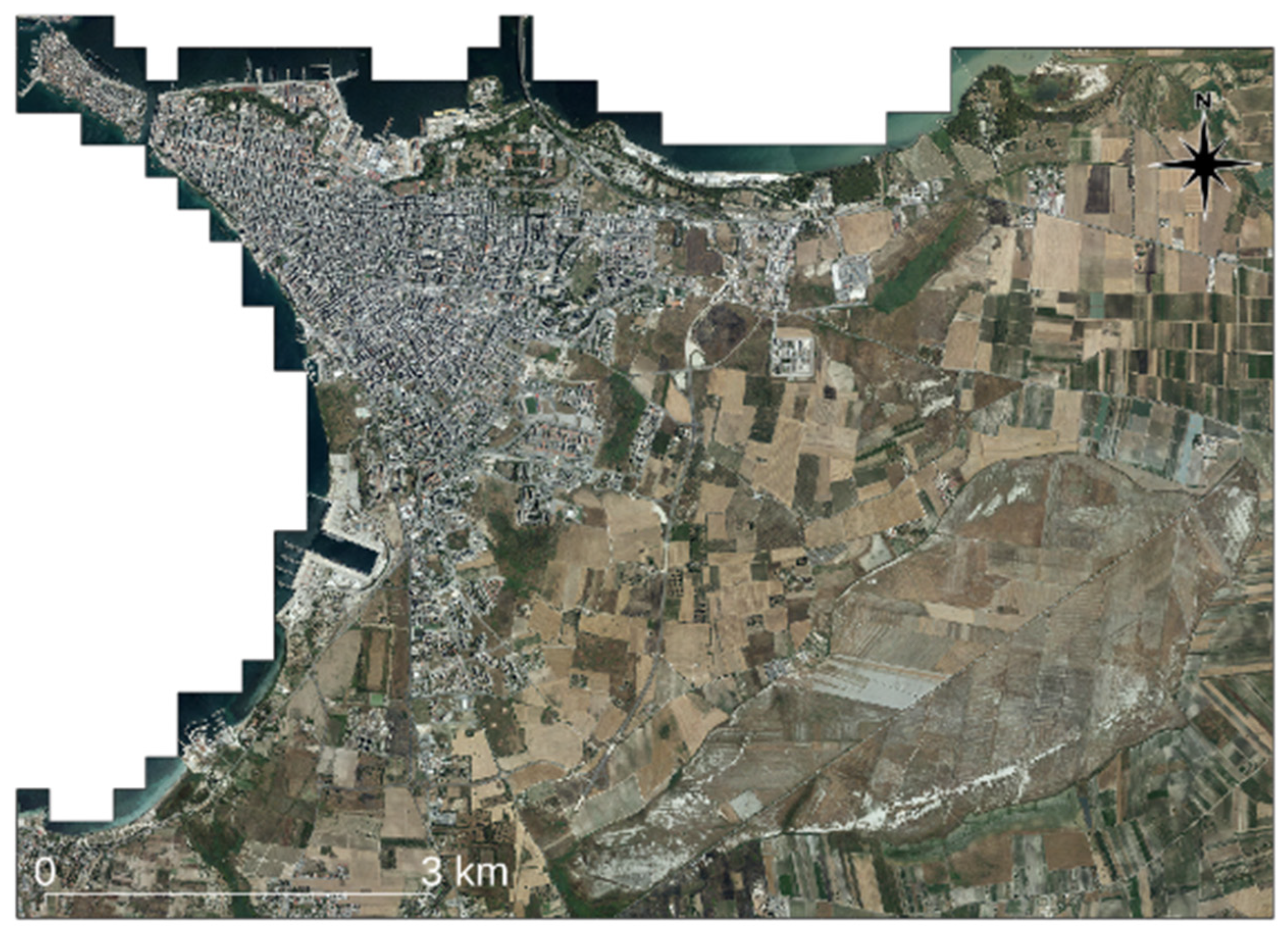
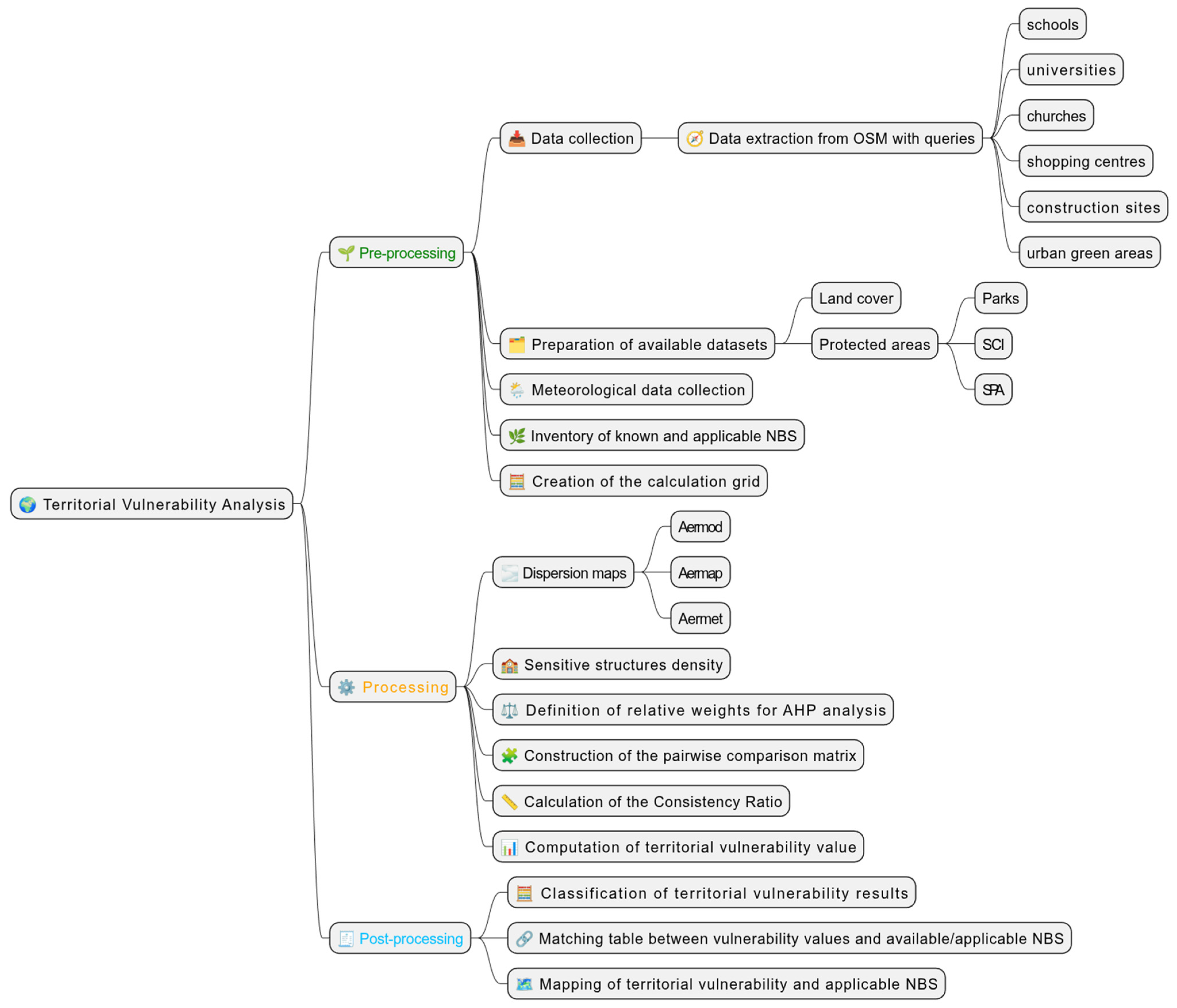

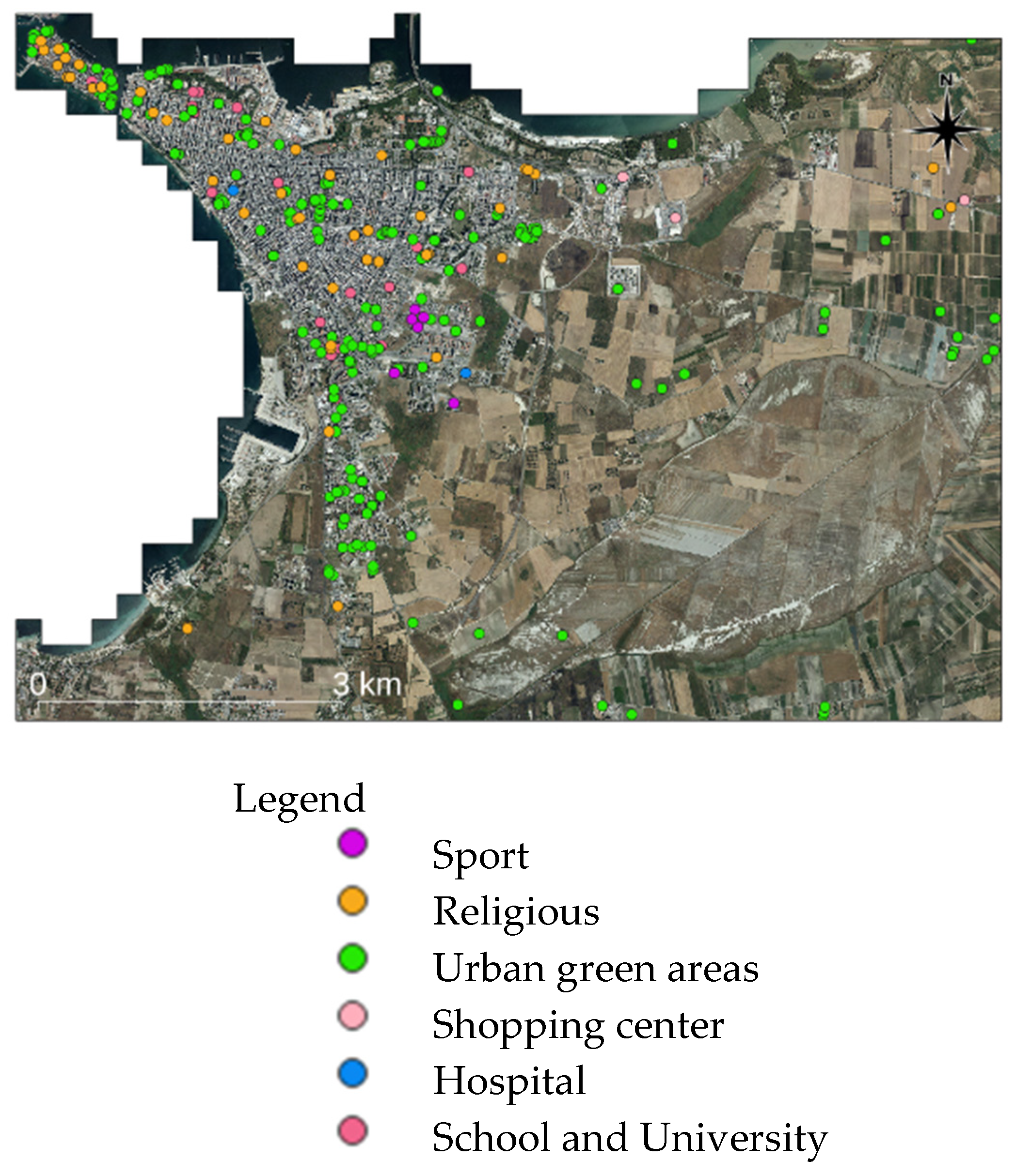
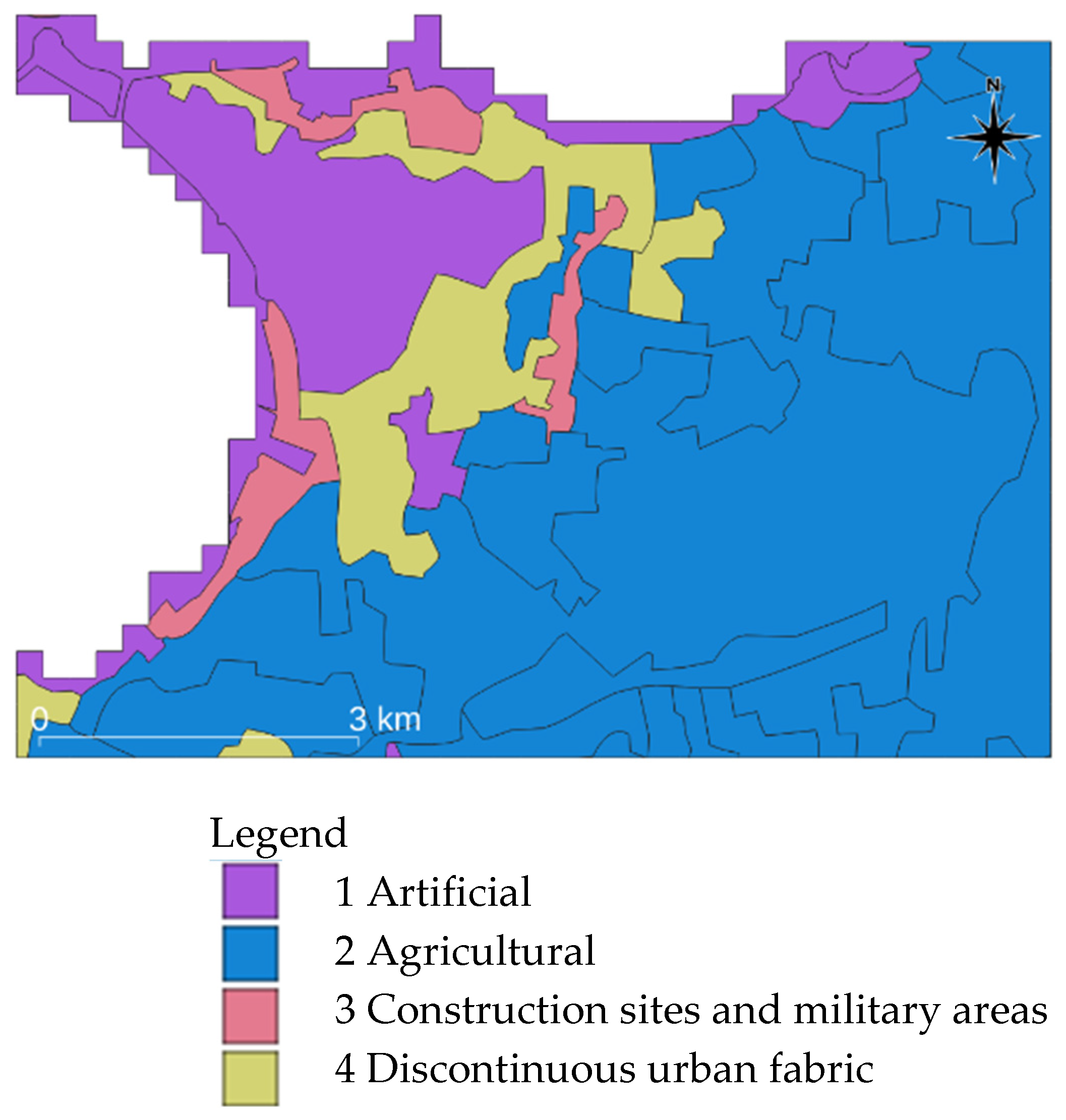
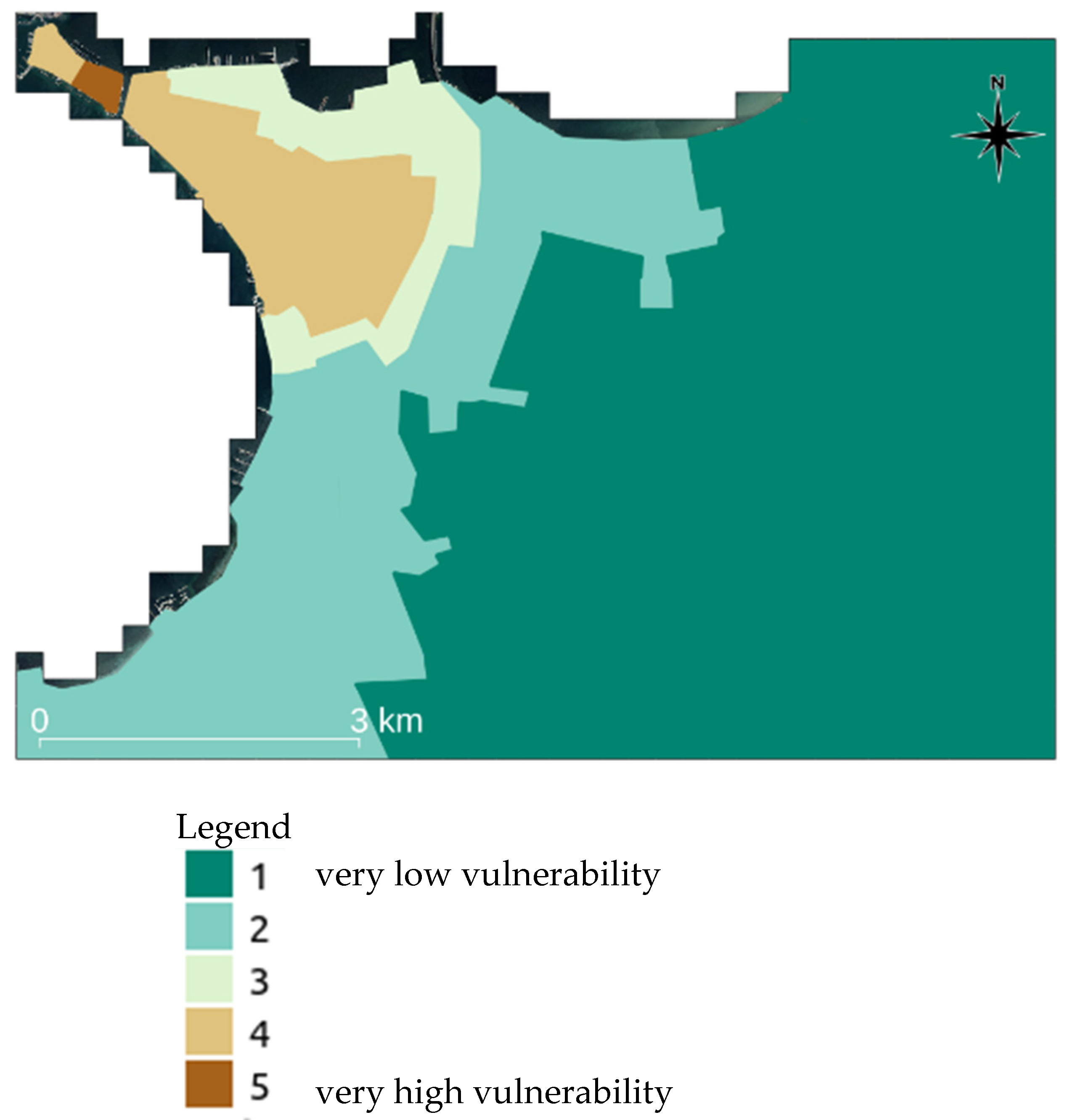
| Code | Component | Parameter | Description |
|---|---|---|---|
| U | Land Use | Agricultural, artificial (residential and industrial), woodland, or wetland | Assessment of anthropogenic pressure |
| S | Sensitive services | Schools and universities, churches, hospitals, shopping centres, and sports fields | Social vulnerability indicators |
| E | Ecosystems | Green areas and protected areas | Environmental mitigation capacity |
| D | Dispersion | Accumulated concentration of PM10 contaminants at ground level | The value of PM10 concentration accumulated on the ground |
| C1 | C2 | C3 | C4 | Sum | Weighted Mean | |
|---|---|---|---|---|---|---|
| C1 | 1.00 | 0.33 | 0.33 | 0.33 | 2.00 | 0.10 |
| C2 | 3.00 | 1.00 | 2.00 | 3.00 | 9.00 | 0.45 |
| C3 | 3.00 | 0.50 | 1.00 | 1.00 | 5.50 | 0.24 |
| C4 | 3.00 | 0.33 | 1.00 | 1.00 | 5.33 | 0.22 |
| Vulnerability Area | Suggested NBS Measures | ||
|---|---|---|---|
| Low Pollution Level | Medium Pollution Level | High Pollution Level | |
| Highly urbanised and industrial zones | Green roofs/walls, rainwater harvesting systems, and pocket parks | Rain gardens and bioswales, permeable pavements, and constructed wetlands for industry | Extensive green roofs, vegetative barriers, urban forests and trees, and natural restoration |
| Medium-transition or mixed zones | Green corridors and rainwater reuse systems | Riparian buffer zones, channel naturalisation, and urban regenerative agriculture | Urban forests and trees, floodplain restoration, bioengineering interventions, and large-scale stormwater parks |
| Low-agricultural or natural areas | Terraces and slope stabilisation, agroforestry, living shorelines, and seagrass planting | Natural water retention measures (dams and ponds), soil conservation, and dune restoration | Afforestation and reforestation, large wetland/coastal wetland restoration, and dune creation |
Disclaimer/Publisher’s Note: The statements, opinions and data contained in all publications are solely those of the individual author(s) and contributor(s) and not of MDPI and/or the editor(s). MDPI and/or the editor(s) disclaim responsibility for any injury to people or property resulting from any ideas, methods, instructions or products referred to in the content. |
© 2025 by the authors. Licensee MDPI, Basel, Switzerland. This article is an open access article distributed under the terms and conditions of the Creative Commons Attribution (CC BY) license (https://creativecommons.org/licenses/by/4.0/).
Share and Cite
Massarelli, C.; Binetti, M.S. Improving Urban Resilience Through a Scalable Multi-Criteria Planning Approach. Urban Sci. 2025, 9, 309. https://doi.org/10.3390/urbansci9080309
Massarelli C, Binetti MS. Improving Urban Resilience Through a Scalable Multi-Criteria Planning Approach. Urban Science. 2025; 9(8):309. https://doi.org/10.3390/urbansci9080309
Chicago/Turabian StyleMassarelli, Carmine, and Maria Silvia Binetti. 2025. "Improving Urban Resilience Through a Scalable Multi-Criteria Planning Approach" Urban Science 9, no. 8: 309. https://doi.org/10.3390/urbansci9080309
APA StyleMassarelli, C., & Binetti, M. S. (2025). Improving Urban Resilience Through a Scalable Multi-Criteria Planning Approach. Urban Science, 9(8), 309. https://doi.org/10.3390/urbansci9080309








